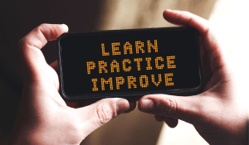Secrets to Smart Practice for Better Results


Every single musician in the world has to practice. It’s just, something you have to do if you want to get better, and like practicing for anything else there are good and bad ways to do it. If you practice daily and don’t see results there could be a fundamental issue with your embouchure, but it could just be that the way you practice is not productive and you’re wasting time. After you seek help from a teacher and establish that your embouchure setup and daily routine are correct, check out my top 10 trumpet practice tips to get your solo, etude or band piece to the next level faster.
Other tools important for successful practice: Tuners & Metronomes │ Improvement Tools │ Practice Technology
Use a Metronome
If you’re wondering what a metronome is, check out the tuners and metronomes page for more information. Basically, it’s a device that keeps a steady beat for you. They can be found at music stores, in your phone’s app store and online. Using this device in your practice is the mother of all practice tips. Why? Because rhythm accuracy is the #1 problem in learning musicians, and it is also one of the most important skills a musician should have. The more you use a metronome and stop relying on your foot for timing, the more settled your inner rhythm will become. You will begin to establish a sense of timing that comes from the consistent use of a metronome, which is always right. Use it in your warmup, routine, scale work, solo and band music, and you will see yourself become more and more confident in your rhythmic skills.
Slow It Down to Half Speed for One Week
I actually remember doing this myself during my Master’s degree while preparing for a concerto recital and I can’t tell you how eye opening it was. The piece, which was the Pakhmutova Concerto, has a section that goes half note equals 96, which is the same as quarter note equals 192. It was fast! My teacher at the time instructed me to practice at half speed for one week, so I did, and let me tell you it was enlightening. Enlightening because playing it so slowly allowed me to hear things I hadn’t heard before. Suddenly tuning issues that had gone unnoticed where coming to light, I was able to practice and perfect the multiple tonguing sections and really workout the interval jumps. This is in my opinion the most effective practice technique there is. It does require a whole lot of patience and dedication.
Micro Chaining Slowly or at Full Tempo
Have you ever played a piece of music that has this one part with bunch of notes going really fast and you just can’t get it right? Yea me too, and I’m going to tell you how I fixed it. Chaining comes from the idea of an actual metal chain, which is made of single links put together. Once the links are welded in place it is impossible to pull the chain apart. In practice, we can do the same thing. Take the measure that is causing you trouble, turn on your metronome to something slow like 60, and play the first two notes. Play those two notes three times. If, and only if, you got it right all three times, add another note. See how it works? Once you complete the measure or section you can speed it up slowly. Another way to chain is to do the same thing but with the metronome at full tempo, an approach I recommend for intermediate and advanced players.
Macro Chaining Slowly or at Full Tempo
You guessed it! Macro chaining is the same as micro chaining but for bigger sections. While micro chaining chains individual notes, macro chaining works on putting small sections together such as measures. This is the best practice technique for those who have most of the piece down but struggle to bridge large sections together. Let’s say you can play the first 2 measures really well, then always miss one note, and then the following 2 measures sound great. Instead of trying to practice all 4 four measures over and over again, just practice the transition between them, just the trouble spot. This is macro chaining. Once the transition sounds solid you can try to put all 4 measures together. This type of practice works great for pieces that have a lot of tempo, time signature and key signature changes.
Get our newest tips, updates, videos, clinics, community events, and more by joining Denis Wick Tips Blog
Don't Start at the Beginning
The best way for me to show you how silly it is to always start at the beginning of your solo is this; when you read a book, do you restart it every time you pick it up? No! That sounds crazy, right? It makes no sense. Why start at the beginning of your solo, at the part you already know, if what you need to work on is actually half way through the page? Avoid wasting time and start where you need the most work. My students say it’s just easier to start at the beginning because you can “get into it” better. My response is always the same; you must be able to start anywhere. Imagine a dancer rehearsing for a ballet solo. Do you think she dances the piece from the beginning every time she needs to work on measure 32? Of course not! If she did, she would end up exhausted by the time she arrives where she needs the most work. This is often what happens to musicians too. Practice smart and see the progress that is possible.
Sing, Buzz, Play
I know what some of you are thinking; “Singing?! I don’t sing!.” Well guess what, if you’re a musician you’re already singing through your instrument. I’m not saying you have to be a singing rockstar but it is very important for musicians of any kind to be able to sing in pitch and to match pitch. The sing, buzz, play practice technique revolves around the idea that if you can sing it, you can play it. First you sing the piece out loud, making sure you’re singing correct pitches, then you transfer that to the mouthpiece and buzz the piece, and finally to the trumpet to play the piece. It’s important to be able to sing and buzz in pitch for this technique to be effective. When it’s done correctly, it’s a triple whammy practice session! Remember that air creates the notes, but your mind’s ear creates the pitch.
Record Yourself
Recording yourself playing is an incredibly effective practice technique that many professional musicians around the world use. You see, what we hear when we play is not always what is actually coming out of the bell. It’s not until you listen back to yourself that your realize the problems that need fixing. Sometimes hearing yourself can be a little down-putting as it is never easy to accept that we need more work, but accepting our flaws is the first step towards fixing them. You can use your phone, a computer or an actual microphone to record yourself. I highly recommend this!
Clap Those Rhythms
Although for some students rhythm comes naturally and it seems easy to read complicated rhythms, I’ve found that most have trouble. If you’re one of those, it is OK, it is normal and it can be fixed with dedication. One of the best ways to practice rhythm is to take what you’re working on and clap the rhythms with a metronome on, while recording. This way you can isolate the rhythms and not worry about notes and playing the instrument. Then listen back to the recording and try to pick out your problem spots. When you can successfully clap the rhythms of your piece you can play it with more confidence.
Visualize Your Success
This is a great practice technique for solo and recital preparation. Visualization is closing your eyes and imagining yourself not just playing the piece beautifully, but imagining everything around you as well. The audience, the room, what you’re wearing, how you walk onto the stage, the stand and sheet music, the entire performance in detail and the applause afterward. Imagining the entire situation can be very helpful to battle nerves and to prepare you to face the performance as if you’d already done it before. Your mind’s power can be used to imagine perfect performances, so that when you actually play you will feel as though you’ve played it perfectly already.
Focused Sprints
A musical sprint is a short but extremely focused practice session. This is helpful for those of you who have a hard time staying focused or simply don’t have the time. Here’s how you do it: set a timer for 10-15 minutes and go full focus until it goes off. When the it’s over walk away, see that’s the key. In order for this type of practice to be successful there can be no distractions such as cell phones and people. Full focus means you think of absolutely nothing but what you’re playing for the entire sprint, and really paying attention to each and every detail of your playing. I highly recommend this type of practice for intermediate and advanced students.
Get more great tips from Denis Wick artist Estela Aragon by visiting trumpetheadquarters.com!

Is your mute older than ours? Visit our Denis Wick Artist Group Oldest Mute Gallery to view our collection and submit an image of your own mute, or story of your favorite dent, to be added to our gallery.

Find all our Denis Wick resources in one spot on the Denis Wick app. Download to view videos, clinics, educator resources, podcasts, product information & more!



